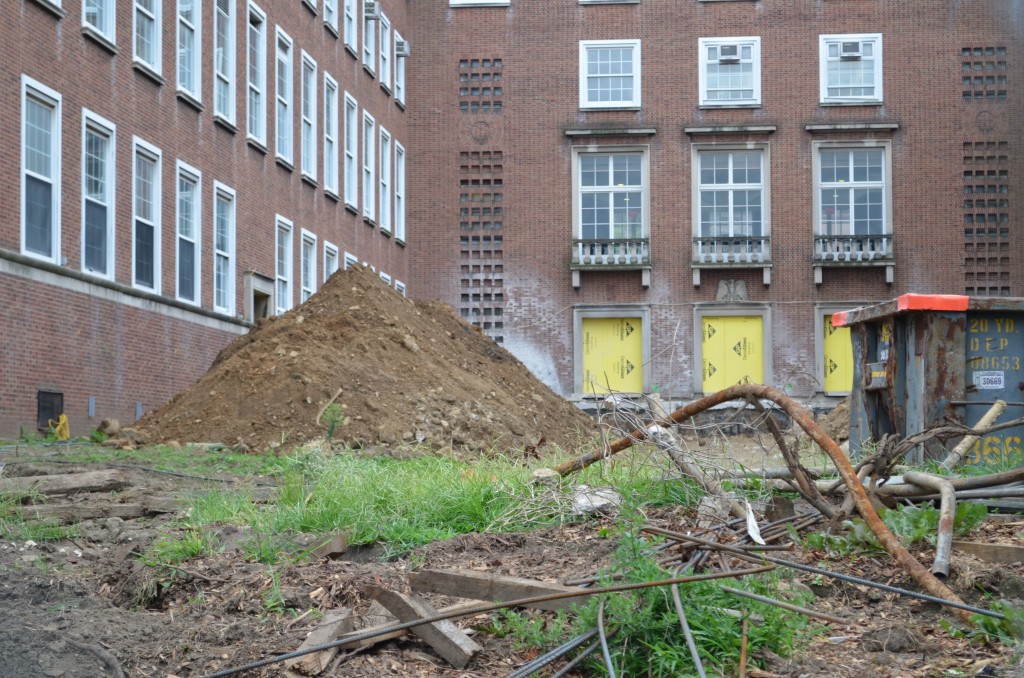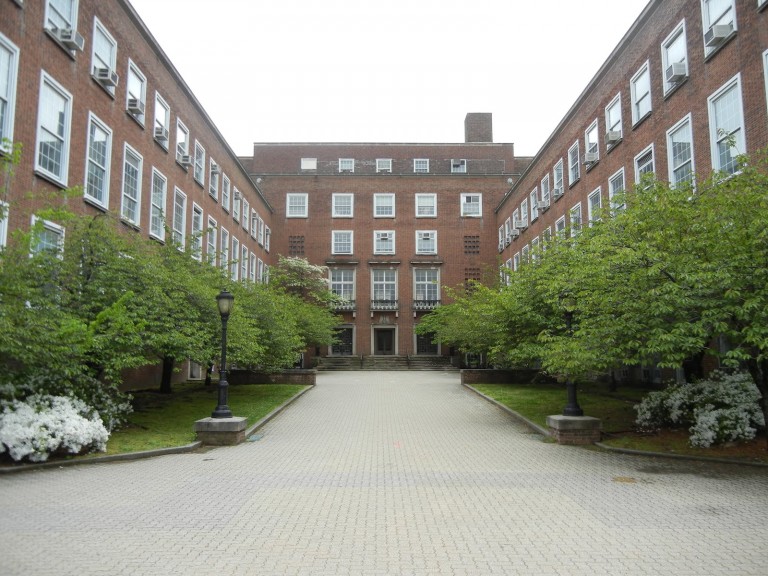
This picture, taken on August 14, contains nothing but splintered remnants of trees and construction equipment where two dozen trees stood less than one month ago. Forum Newsgroup photos by Natalia Kozikowska.
Earlier this week, the city plowed down 24 cherry trees that sat behind Queens Borough Hall on an arborists’ advice. The city claimed these trees were sick but environmentalists believe the decision was based solely on cost.
It all began in April when nine Cherry Trees were chopped down after a report from the city claimed that the trees were diseased. Geoffrey Croft, president and founder of New York City Parks, said the reports were false and that those trees were in fact, healthy.
“We found an email from one of their own consultants that said the trees were in good condition. Of course, once they got caught, they tried to cover it up,” said Croft. “They [the city] were not able to provide any documentation whatsoever. In fact, they told us there were trees right for candidacy for saving.”
The email exchanged between agency officials and DCAS, the landscaping firm formerly responsible for developing the $17 million atrium project, revealed that only three out of the nine trees contained bacterial and fungal infections.
Dan Andrews, press secretary for Borough President Helen Marshall, said that the city relied on a report from the Department of Citywide Administrative Services that stated that the trees were diseased. “We took that to mean that it was all the trees but it seems not all the trees, the entire amount, [nine] may have been diseased,” he said.
In addition, Andrews revealed that those trees needed to be removed because the area was needed to bring in construction equipment for the project. “We’re not tree experts so we were made aware that this was the action needed to be taken.”
Following the incident, Croft said he was promised that the remaining 24 trees that stood in the courtyard would be preserved. When he discovered that the city had removed the trees he was furious.
“They promised to save the remaining trees and once they found out what the cost was they went back on their promise,” he said.
Although the 2009 email suggests that the number of sick trees may have been skewed, Andrews said that a recent assessment by an arborist concluded that the remaining trees had a small chance of survival.
“They had been there for numerous years and the probability for their survival was not good. The age, size and season, as it relates to the trees, was not good for the transplanting. Although there was a consideration that some of these trees could be transplanted, most factors indicated replacement of an adequate number of younger, healthier trees would have a better probability of success.”
While Andrews insists the trees were chopped down because there was only a small chance of survival, he also noted that transplanting and maintaining the trees is an expensive process.
“There was a considerable amount of money involved in transplanting each tree and then there was also the thousands of dollars that would have had to be paid to maintain the trees after they were transplanted for a couple of years. There was no guarantee that they would be successfully transplanted,” he said. He estimated the cost to transplant ten Cherry Trees was $120,000.
Croft remains skeptical that the trees he was once promised would be left alone were removed because they were sick and maintains the only reason they were removed was because of the cost.
“Once they found out what the price was, they weren’t going to bother,” he said. “Unfortunately as we’ve seen time and time again, the city does not seem to care about trees that are not part of their Million Trees NYC Program.”
He also suggested that if the city wanted to preserve the trees they could have waited until it was the right season to transplant them. “If they wanted to save the trees they could have waited but this, of course, would delay the atrium project… and they don’t want that.”
The city plans to plant about 50 trees in the area that the trees were removed. “We decided to plant new trees – approximately double the trees that were removed, and they will be young and healthy. This was the better option based on our expert opinion,” said Andrews.
For Croft and other environmentalists, this option is short of a solution.
“We’ve been told that there were a couple of red-tailed falcons that lived on the very next block of this building. We’ve also been told by a couple of people that the area was a training ground for newborns. It was a beautiful growth and obviously had value beyond the environment. People also come there to paint, take pictures and get exercise. It was a really special spot.”
By Natalia Kozikowska

